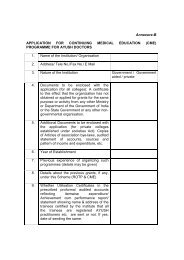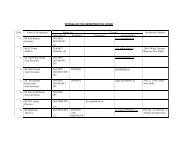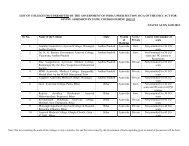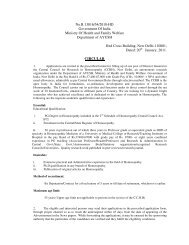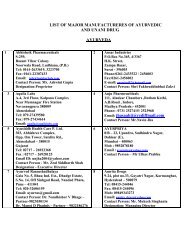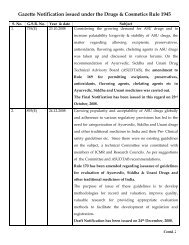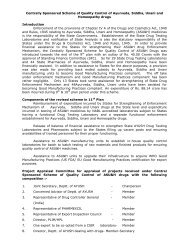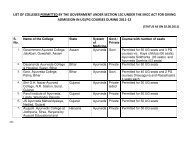Ayurvedic system of medicine is of great antiquity - Department of ...
Ayurvedic system of medicine is of great antiquity - Department of ...
Ayurvedic system of medicine is of great antiquity - Department of ...
Create successful ePaper yourself
Turn your PDF publications into a flip-book with our unique Google optimized e-Paper software.
forms, from decoctions, powders, general pills,<br />
precious pills, and syrups, and are prescribed in<br />
small doses.<br />
B. MISSION, VISION AND OBJECTIVES<br />
OF DEPARTMENT OF AYUSH:<br />
The M<strong>is</strong>sion, V<strong>is</strong>ion and objectives <strong>of</strong> the<br />
<strong>Department</strong> <strong>of</strong> AYUSH are given below:<br />
(i) M<strong>is</strong>sion and V<strong>is</strong>ion:<br />
The m<strong>is</strong>sion statement <strong>of</strong> <strong>Department</strong><br />
<strong>of</strong> AYUSH <strong>is</strong> as follows:<br />
� Promotion and propagation <strong>of</strong><br />
Ayurveda, Unani, Siddha, Yoga,<br />
Naturopathy and Homoeopathy<br />
<strong>system</strong>s <strong>of</strong> <strong>medicine</strong> in India and<br />
abroad and to attain global<br />
leadership <strong>of</strong> the country in the field<br />
<strong>of</strong> traditional <strong>medicine</strong>.<br />
� Establ<strong>is</strong>hing a dynamic and vibrant<br />
education <strong>system</strong> for these<br />
<strong>system</strong>s <strong>of</strong> <strong>medicine</strong>.<br />
� Developing <strong>of</strong> the two regulatory<br />
bodies, four Central Research<br />
Councils, eight national institutes,<br />
two apex laboratories, four<br />
Pharmacopoeial Committees and<br />
Indian Medicines Pharmaceutical<br />
Corporation Ltd.(IMPCL) as model<br />
organization in their respective<br />
fields.<br />
� Focusing a need-based research<br />
with due emphas<strong>is</strong> on emerging<br />
epidemiological shifts and<br />
potentiality <strong>of</strong> the <strong>system</strong>s.<br />
� Recognition <strong>of</strong> other countries for<br />
AYUSH <strong>system</strong>s for health care<br />
and focusing on the marketing <strong>of</strong><br />
AYUSH products in the markets <strong>of</strong><br />
developed countries to attain global<br />
leadership.<br />
� Completing drug standardization<br />
for classical formulations, ensuring<br />
good manufacturing practices, and<br />
strengthening regulatory<br />
mechan<strong>is</strong>m.<br />
� Integration <strong>of</strong> Indian Systems <strong>of</strong><br />
Medicines and Homoeopathy in the<br />
national health programmes and<br />
health delivery <strong>system</strong> and<br />
expansion <strong>of</strong> AYUSH based health<br />
care <strong>system</strong>s.<br />
(ii) Objectives:<br />
The <strong>Department</strong> <strong>of</strong> AYUSH has the<br />
following objectives:-<br />
6<br />
� Promoting good health and<br />
expanding the outreach <strong>of</strong> health<br />
care<br />
� Improving the quality <strong>of</strong> teachers<br />
and clinicians <strong>of</strong> various AYUSH<br />
<strong>system</strong>s<br />
� Ensuring affordable AYUSH<br />
services and drugs which are safe<br />
and efficacious<br />
� Facilitating availability <strong>of</strong> raw drugs<br />
which are authentic and contain<br />
essential components<br />
� Integrate AYUSH <strong>system</strong>s in health<br />
care delivery <strong>system</strong> and National<br />
Programmes<br />
� Re-orientation and prioritization <strong>of</strong><br />
research in AYUSH <strong>system</strong>s<br />
� Creating awareness about the<br />
strengths <strong>of</strong> AYUSH <strong>system</strong>s in<br />
India and abroad and sensitizing<br />
other stakeholders and providers <strong>of</strong><br />
health, and<br />
� Providing full opportunity for the<br />
growth and development <strong>of</strong> AYUSH<br />
<strong>system</strong>s.<br />
C. NATIONAL MEDICINAL PLANTS<br />
BOARD (NMPB):<br />
India has one <strong>of</strong> the oldest, richest and<br />
most diverse cultural traditions associated with<br />
the use <strong>of</strong> medicinal plants. World Health<br />
Organization (WHO) has estimated that<br />
approximately 80% <strong>of</strong> the world population<br />
relies on traditional <strong>medicine</strong>s which are mostly<br />
plant-based drugs. About 7500-8000 species <strong>of</strong><br />
plants are estimated to be used for human and<br />
veterinary health care in the country, across the<br />
various eco<strong>system</strong>s from Ladakh to<br />
Kanyakumari and from Rajasthan to the hills <strong>of</strong><br />
the North-East India. Indian <strong>system</strong>s <strong>of</strong><br />
<strong>medicine</strong> use various raw materials <strong>of</strong> which<br />
medicinal plants constitute 90% <strong>of</strong> the raw<br />
material. About 3000 plants species are<br />
reported to be used in the codified Indian<br />
Systems <strong>of</strong> Medicinal like Ayurveda (900<br />
species), Siddha (800 species), Unani (700<br />
species) and Amchi (300 species). The rest <strong>of</strong><br />
the species are used in local health traditions<br />
and with folk Indian <strong>system</strong>s. Medicinal plants<br />
thus contribute an important component <strong>of</strong> the<br />
plant resource wealth <strong>of</strong> our country. In addition<br />
to their use in the preparation <strong>of</strong> Tradition<br />
<strong>medicine</strong>s, the medicinal plants are being used<br />
in preparation <strong>of</strong> various pharmaceuticals and




